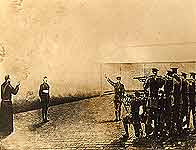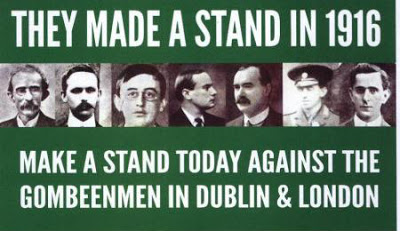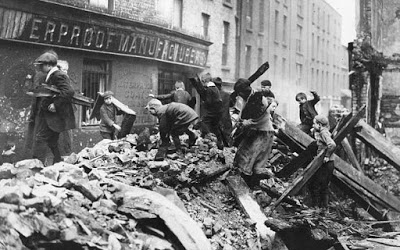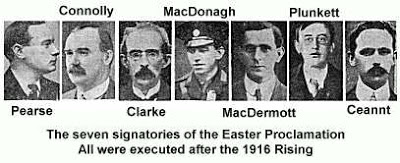A United Ireland is yet to be achieved
William Butler Yeats: “Easter, 1916”
Ireland
was partitioned at almost exactly the same time that the British
Mandate for Palestine took effect. Presiding over both was Winston
Churchill, the colonial secretary. In the words of its first Military
Governor, Sir Ronald Storres (Orientations) a Jewish state would be ‘a
little loyal Ulster in a sea of hostile pan-Arabism’
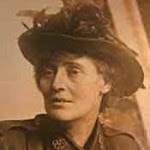 |
| The Countess Markievicz – socialist, feminist, member of the first Irish government |
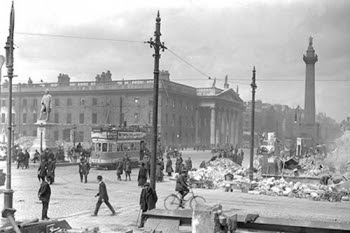 |
| Dublin’s GPO after the Rising |
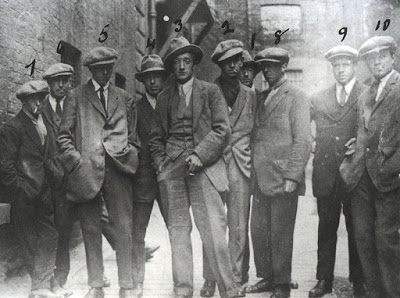 |
| The Cairo Gang – a group of Police Intelligence Agents & Informers that the IRA killed in November 1920 |
From a British loyalist point of view, they were traitors who had tried to overthrow a lawful government. The anger was multiplied by the belief held by many that Germany had been behind the Rising. This was completely untrue but it helped to fuel the sense of outrage, both in Britain and among many people in Ireland.
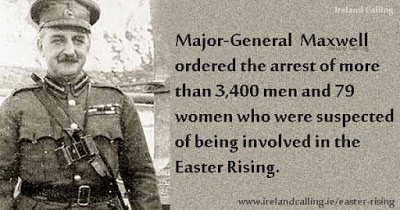 |
| General Maxwell – British war criminal who snatched defeat out of victory |
However, as each execution took place, public opinion began to change. People started to learn more about the leaders and their motives. They realised that far from being puppets of Germany, they were idealists who were willing to sacrifice their lives for their belief in the need for an independent Ireland. Many were also moved by the quiet and dignified way in which the leaders faced their execution; refusing to blame the soldiers about to shoot them and in some cases even being prepared to pray for them.
1916 the Easter Rising represented the resumption of the struggle for Irish
freedom. The decision in 1914 of the Irish National Volunteers and the Irish
Parliamentary Party to support the British government in the inter-imperialist
war effectively subsumed the national movement. By 1916 hopes for an early
victory by either side in the war had disappeared. It was time to reclaim hope
for Ireland at home, from its slaughter overseas.
though they appeared, the most advanced forces of Republicanism and the
workers’ movement, understood that the war temporarily weakened the British
government’s grip on Ireland. The Rising was an attempt to secure the military
and political foundation for an independent Irish state. It was completely
serious in intent and execution, and its subsequent failure could not be
determined beforehand.
defending the Rising, Lenin wrote:
is the misfortune of the Irish that they rose prematurely, before the European
revolt of the proletariat had had time to mature. Capitalism is not so
harmoniously built that the various sources of rebellion can immediately merge
of their own accord, without reverses and defeats. On the other hand, the very
fact that revolts do break out at different times, in different places, and are
of different kinds, guarantees wide scope and depth to the general movement;
but it is only in premature, individual, sporadic and therefore unsuccessful,
revolutionary movements that the masses gain experience, acquire knowledge,
gather strength, and get to know their real leaders …”[1]
in July 1916, Lenin could not know that the Rising was only “premature” by a
few months, for in February 1917 the Russian Revolution began. But Lenin fully
grasped how significant this action was in Europe as demonstrating the
vulnerability of the British Empire.
imperialist bourgeoisie by a rebellion in Ireland is a hundred times more
significant politically than a blow of equal force delivered in Asia or
Africa.”[2]
was following the classical Marxist estimate of the significance of Irish
freedom, as established by Marx and Engels:
capitalism, the only point where official England can be struck a great blow is
Ireland. … The moment the forced union between the two countries
ends, a social revolution will immediately break out in Ireland, though in
outmoded forms … Any people that oppresses another people forges its own
chains.”[3]
1916, landlordism, particularly absentee landlordism, was far less significant
in Irish society, than in 1870 when Marx wrote the above. The Land League
campaigns had won rent reductions. This hadn’t benefitted landless labourers,
but it had aided small farms. Land Acts, culminating in the Wyndham Act of 1903
saw a modernisation of property relations in farming. 11 million acres of land
were sold to farmers, with the British government subsidising the departing landlords.
The Rising, and the revolution from 1918 – 1922, assumed a form Marx couldn’t
have foreseen.
the logic behind the timing of the Rising had been anticipated by both a
classical and a contemporary Marxist:
Irish rebellion has not the slightest chance … “[4]
huge power of the British Empire was not to be lightly assessed by Irish
revolutionaries. But its vulnerability must not be ignored.
teach that the “far flung battle line” of England is weakest at the point
nearest its heart, that Ireland is in that position of tactical advantage, that
a defeat of England in India, Egypt, the Balkans or Flanders would not be so
dangerous to the British Empire as any conflict of armed forces in Ireland,
that the time for Ireland’s battle is NOW, the place for Ireland’s battle is
HERE. That a strong man may deal blows with his fists against a host of
surrounding forces, and conquer, but will succumb if a child sticks a pin in
his heart.
Government as being a subject ripe for discussion, that moment our policy
will be for peace and in direct opposition to all talk or preparation for
armed revolution. We will be no party to leading out Irish patriots to meet the
might of an England at peace.”[5]
the heart of the Rising was an alliance between the forces of revolutionary
nationalism, and those of revolutionary Marxism. The common command of the
Volunteers and the Irish Citizen Army was a practical expression of common
aims, to use “England’s difficulty” to achieve Independence and the Republic.
social basis of the Volunteers was the more varied including intellectuals,
professionals, farmers, rural labourers, and urban workers. They were united by
their interest in the free development of Ireland, and their preparedness to
risk all for that. The social basis of the Irish Citizen Army lay in the
extraordinary working class struggles in urban Ireland, particularly Dublin
1913. Led by Connolly, Larkin and Markievicz, a fusion had been made between a
section of Irish workers and Marxist politics which opposed Ireland’s national
oppression and the exploitation of its working class. According to Connolly,
the Irish working class had become “… the
incorruptible inheritors of Irish freedom”.
the Irish Volunteers were around 11,000 strong, only about 1,150 took part in
the rising. The more passive section of the leadership under Eoin MacNeill
countermanded the mobilisation orders, cutting off vital support for the
Rising. The Irish Citizen Army was even smaller, only 152 members took part in
the Rising. There were around 90 women on the barricades.
the Rising was maintained against the British Army for six days, from Easter
Monday, 24th April 1916. This is a tribute not just to the military
skills and bravery of the insurgents. The morale of fighters is crucial in war.
By the manner in which they carried the battle, organised the surrender, and
held themselves through the subsequent executions, it is obvious that this was
an army whose morale was of the highest order.
source of this can be seen in the political aims of the Proclamation of the
Republic. The document bears the imprint of both the long tradition of
revolutionary nationalism, and the more recent tradition of socialism in
Ireland.
ownership of Ireland, and to the unfettered control of Irish destinies, to be
sovereign and indefeasible”. This statement of the sovereignty of Ireland’s
people over the land, from sod to sky, is in sharp counter-position to the
efforts being made by the Tories, Liberals, and Unionists to split the nation
by allowing part of Ulster to be separated from any devolved parliament. A
position being unwisely tolerated by the Redmonites on the assumption of post
war concessions from British imperialism.
comrades-in-arms to the cause of its freedom, of its welfare, and of its
exaltation among the nations.” The combatants’ inspiration also lay in the
generations of past fighters, and in anticipation of a nation reborn in their
struggle.
the allegiance of every Irishman and Irishwoman. The Republic guarantees
religious and civil liberty, equal rights and equal opportunities to all its citizens,
and declares its resolve to pursue the happiness and prosperity of the whole
nation and all of its parts, cherishing all of the children of the nation
equally and oblivious of the differences carefully fostered by an alien
government, which have divided a minority from the majority in the past.”
contribution of the socialist and feminist element of recent Irish history is
forcibly expressed. It is a command to Irish women as much as Irish men. It
guarantees their equality in its foundation and functioning. The remarkable
statements of religious and civic equality are in contrast to the
institutionalised discrimination imposed by the occupying power, and sustained
by reactionary forces that benefitted from such discrimination. Without a trace
of bitterness or recrimination, the Republic will embrace the whole of the
island’s people, “cherishing all of the
children of the nation equally”.
Proclamation does “place the cause of the
Irish Republic under the protection of the Most High God”, but the content,
and élan, of the document removes any doubt that whatever the citizen’s faith
or conviction their rights are assured.
Proclamation demonstrates that the Rising was extremely advanced in political
conception. The revolutionary nationalist/Marxist bloc created a more coherent
aim than comparable contemporary risings against imperialism. In Iran from
1905-1911, and in China in 1911, we see extraordinary actions by revolutionary
nationalist forces which seriously shook imperialism. But in neither case did
the working class participate in an autonomous manner.
the Easter Rising was the first example of a new type of revolution in
oppressed nations – an alliance between the advanced nationalist forces and socialist
forces, or in class terms between the petty bourgeois masses and the working
class. This was an anticipation not just of the Russian Revolution of 1917, but
also most of the major revolutions since then.
its defeat, it is evident that the Rising renewed the determination of the
Irish people to secure their freedom. The first opportunity that the masses of
Irish people had to express this determination was in the General Election of
December 1918. Sinn Féin secured 73 of the 105 Parliamentary seats in Ireland.
In January 1920, the municipal elections were equally convincing. Sinn Féin won
550 seats; the pro-independence Irish Labour Party won 395, the Unionists 238
and the Redmondite Nationalists 108.
wisdom of the Rising leaders was clear to all once the British government
refused to respect the wishes of the Irish electorate. It refused to recognise
Dáil Éireann convened as the Irish parliament in January 1919. It commenced
armed repression and prepared legislation for the partition of Ireland, hoping
to retain overall control.
rejection of Ireland’s decision led to the revolutionary war of independence.
The Irish people stood up for their freedom, and fought the occupying power to
a standstill.
establishment of a new Irish state, mutilated by partition, represented the end
point of this period of struggle. Having experienced uninterrupted warfare from
1914 – 1922 it is likely that exhaustion played a part in the victory of the
pro-Treaty forces.
war of independence drew in all the forces of Ireland, bourgeois, petty
bourgeois and working class. But the working class had been divided by loyalist
sectarian campaigns and intimidation in the North. It had also lost its finest
leaders in the executions after the Rising. The Irish Labour Party did not have
a comparable leadership, and had stood down in the Parliamentary elections to
allow Sinn Féin a clear run on behalf of all the revolutionary nationalist
forces.
execution is particularly significant. Of all the Marxists to have operated in
the British state since the time of Marx and Engels, Connolly remains the most
influential and profound. Perhaps only John MacLean and Sylvia Pankhurst can be
spoken of in comparable terms. But neither of these achieved the national and
international standing of the key political and military leader of the Easter
Rising.
one understands the Treaty, its opponents did not know how to restore a social
alliance which could continue the struggle for complete Irish freedom.
Partition of Ireland unleashed, as Connolly predicted, “a carnival of reaction”
in the new Irish state, and in the British state in six county Ulster.
the South, the concentration on nation building was given a more religious
expression than in the Proclamation, with the Catholic Church being given undue
weight. Neither the Pro-Treaty forces, nor De Valera’s “anti-Treaty” party
differed greatly on this. The promotion of the Irish economy was important, but
badly hampered by being cut off from the industrial centres in the North of the
country. Equally the establishment of formal independence was marred by
partition. Neither the pro or anti-Treaty parties in the Dáil showed any
initiative in securing the reunification of Ireland.
the North, the Parliament at Stormont was based on the political monopoly of
Unionism. At a meeting of the Sinn Féin delegation and guests after the
re-opening of Stormont under the Good Friday Agreement, Martin McGuinness told
those present that the only piece of Nationalist originated legislation passed
by Stormont between 1922 and its dissolution in 1972 was the Protection of Wild
Birds Act. Such monopoly power was aligned to a complete ascendency in social
terms on issues of employment, housing, welfare services, education and the general
allocation of public resources.
settlement after 1922 clearly did not meet the “sovereign and indefeasible”
rights of the Irish people. It had been imposed upon the Irish nation under
Lloyd George’s threat of “immediate and terrible war”. After the Dáil had
carried the Treaty, the subsequent General Election was held to the Free State
legislature. Even then, Winston Churchill, combining belligerence with racism,
warned that if a republican majority was returned “the resources of civilisation are by no means exhausted”.
pro-Treaty forces were composed of those, like Arthur Griffiths, who were
prepared to accept remaining part of the British Empire, and those like Michael
Collins, who regarded the Treaty as a staging point to a later independence and
unification of the country. This “tactical” unity to secure the Treaty
demonstrates that in reality there was a majority in favour of completing the
journey to Irish freedom begun in 1916. Collins and allies could have
demonstrated this, had they established a “tactical” agreement with the
anti-Treaty forces.
her book, “Unmanageable Revolutionaries”, Margaret Ward makes a strong argument
that a majority of Irish women were against the Treaty. The six women deputies
to the Dáil were unanimous in their opposition, led by Markievicz and Mary
MacSwiney. Cumann na mBan, the women’s organisation auxiliary to the Irish
Republican Army, voted against the Treaty by a large majority. Mary MacSwiney
told the Dáil:
is the women who suffer, it is the women who suffer the most of the hardships
that war brings. You can go out in the excitement of the fight and it brings
its own honour and its own glory. We have to sit at home and work in more
humble ways, we have to endure the agony, the sunshines, the torture of misery
and the privations which war brings, the horror of nightly visitations to our
houses and their consequences. It is easier for you than it is for us, but you
will not find in Ireland a woman who has suffered who today will talk as the
soldiers here today have of talked, and I ask the Minister of Defence, if that
is the type of soldier he has, in heaven’s name send the women as your officers
next time.”[7]
significance of the Easter Rising is then also that it reminds us that the
national revolution is still incomplete in Ireland today. The “national
question” is an essential part of Irish contemporary politics, and will remain
so until Ireland is unified and free from the ability of the British government
to direct the lives of part of the island’s inhabitants. 1916 is a signpost to
Ireland’s future, as much as it’s’ past.
the left in Britain did not understand this at the time, and nor does much of
it now. Geoffrey Bell’s excellent new book, “Hesitant Comrades” gives a full
account of British left responses to 1916. He highlights J.H.Thomas, Labour MP
and General Secretary of the National Union of Railwaymen, who:
with which Labour’s leaders reacted to the Rising. He also maintained, ‘There
was no Labour leader in this country who did not deplore the recent rebellion
in Ireland’.”[8]
goes on to cite George Lansbury, and Bruce Glasier for the Independent Labour
Party who condemned it from a pacifist perspective. Further to the left, the
British Socialist Party paper recognised that it was an “… effort of the Irish people to throw off the alien yoke”, but that
it was “foolish”. Sylvia Pankhurst’s
“Women’s Dreadnought” was the most sympathetic, whilst still characterising the
Rising as “reckless” but “… undoubtedly motivated by high ideals”.
Rising, as a new type of revolution, was a test for all the socialist trends in
Britain. Those most compromised in their relations with British imperialism
were most hostile to the Rising. Those who were most supportive of Ireland’s
struggle for freedom had to come to terms with their limited experience of
anti-colonial struggles, and learn from the Irish revolutionaries.
to Lenin:
passed through various stages and combinations of class interest, manifested
itself, in particular, in a mass Irish National Congress in America … which
called for Irish independence; it also manifested itself in street fighting
conducted by a section of the urban petty bourgeoisie and a section of the
workers after a long period of mass agitation, demonstrations, suppression
of newspapers, etc. Whoever calls such a rebellion a “putsch” is either
a hardened reactionary, or a doctrinaire hopelessly incapable of envisaging a
social revolution as a living phenomenon”.[11]
responses to Ireland existed aplenty. At its most informed end it premised
opposition to the Rising on Marx’s analysis of the role of the land question:
far, been the exclusive form of the social question; it is a question of
existence, a question of life or death for the immense majority of the
Irish people; at the same time, it is inseparable from the national question;
because of this, destruction of the English landed aristocracy is an infinitely
easier question in Ireland than in England itself – quite apart from the more
passionate and more revolutionary character of the Irish than the English”.[12]
that small “so far” Marx demonstrates
his non-doctrinaire method, allowing for the possibility of change, even in
such an apparently absolutely established phenomenon as the domination of the
land question in Irish politics. But if the land question was solved, this was
merely one form of the “social question”.
The destruction of the link between the land question and the national question
certainly was not the latter’s resolution.
1916, Ireland’s economy still fulfilled the role of farm to Britain, with an
important workshop in the North. It was entirely governed from London. Its
indigenous culture had been repressed and neglected for centuries. Many of its
people had been forced to emigrate by poverty – Ireland had a smaller
population than at the time of the 1841 census, before the great starvation of
1845 – 48.
contemporary and concrete analysis was essential if Marxism was to mean
anything in analysing 1916 and Ireland in general. Classical Marxism had
provided a legacy on the significance of Irish freedom for the British working
class. Marx continued:
two hostile camps, English PROLETARIANS and Irish PROLETARIANS. The
ordinary English worker hates the Irish worker as a competitor who lowers his
STANDARD OF LIFE. In relation to the Irish worker he regards himself as a
member of the ruling nation and consequently he becomes a tool of the English
aristocrats and capitalists against Ireland, thus strengthening their
domination over himself. … The Irishman PAYS HIM BACK WITH INTEREST IN
HIS OWN MONEY. He sees in the English worker both the accomplice and stupid
tool of the English rulers in Ireland.
of the English working class, despite its organisation. It is the secret by
which the capitalist class maintains its power. And the latter is quite aware
of this.
London to make English workers realise that for them the national
emancipation of Ireland is not a QUESTION OF ABSTRACT JUSTICE OR
HUMANITARIAN SENTIMENT but THE FIRST CONDITION OF THEIR OWN SOCIAL EMANCIPATION.”[13]
division within the working class in Britain certainly coloured the politics of
the socialist movement. The refusal, or failure, to confront prejudice amongst
workers was overlaid with anti-Catholic prejudice amongst the socialists –
viewing Irish society as “less developed”
(i.e. reactionary and backward). Equally, British imperialism was at the apogee
of its strength at the start of the 20th century. Its ideological hegemony
in Britain being expressed by the fact that the most influential party created
from the workers movement was a “Labour”
party, rather than a “Socialist”
party as was the case in the rest of Europe.
assertion that the “national emancipation”
(not even “socialist”!) of Ireland
was the “first condition” of the
British working class’s emancipation must then have seemed utterly
incomprehensible to most British socialists. From the vantage point of 2016, it
is clear that the failure of the British working class to support Irish
freedom, and the freedom of those throughout the world oppressed by British
imperialism, blocked any major socialist movement in Britain during the 20th
Century.
form, at least, the international socialist movement, prior to the catastrophe
of 1914, had an appreciation of the significance of the struggle against
national oppression as part of the long struggle for socialism. Referring to
the Stuttgart Congress of the Second International in 1907, Connolly wrote:
Stuttgart, Comrade Bebel declared that one consequence of the growth of
Socialism would be a renascence of national culture and sympathies in countries
now politically suppressed, and he welcomed such a renascence on the ground
that the civilisation of the future would be all the richer from the presence
of so many distinctive forms of intellectual growth arising from different
racial and national developments.
in brief, is the real position of International Socialism towards subject
nations. It is a concept based on the belief that civilisation needs free
nations just as the nations need free individual citizens, that the
internationalism of the future will be based upon the free federation of free
peoples, and cannot be realised through the subjugation of the smaller by the
larger political unit.”[14]
the following figures are taken from Michael Burke’s valuable pamphlet “The
Economic Case for Irish Unity”. In 1921, GDP per capita in what is now the
Republic of Ireland was 45% of what is now Northern Ireland. The latter had a
figure broadly comparable to the UK average as a whole. The disparity between
South and North was a result of the concentration of industry around Belfast.
In 2012, GDP per capita in the Republic of Ireland had become higher than that
of the UK, whilst that of Northern Ireland had declined to 80% of the UK
average.
these figures may be qualified, it is evident that even a partial and mutilated
independence has allowed the Republic of Ireland to grow faster than Britain.
Equally, the initial “protection” that imperialism provided for the six county
state, and especially for the loyalist community, has long since disappeared
with the decline of British imperialism’s world power.
inertia, in the form of continued opposition to Irish reunification, has held
back the development of the Irish nation, on both sides of the border. How
artificial this is was demonstrated by Mary McAleese, former President of
Ireland, in her speech on “Anglo-Irish Relations” to British parliamentarians
on 24th February 2016. She explained that in 1997, prior to the
Peace Process, the land border with the least cross border trade in the EU was
between the Republic and Northern Ireland.
Peace Process has modestly begun to repair this since 1998. But only the
reunification of Ireland, under independent and single governance, can provide
the rising living standards that all on the island of Ireland need. The Houses
of the Oireachtas Joint Committee on Jobs, Enterprise and Innovation Report on the
All-Ireland Economy was published in January 2016. It found that unification
would create:
a long term improvement of GDP per capita in the North of 4 to 7.5 per cent,
while the South would see a boost of 0.7 to 1.2 per cent. … Three unification
scenarios were presented, with the most successful estimating a €35.6 bn boost to All-Island GDP in the first eight years of
unification.”[15]
35.6 billion Euros equates to approximately 6000 Euros for every person in
Ireland. Resolving the national question in its simple political form has
tremendous potential for Irish economic progress. As the economic relations are
the foundation of society, we can assume a wide variety of cultural and social
benefits for a united Ireland arising therefrom.
2016 then Ireland’s reunification and independence remains the key issue for
contemporary politics. Marxists and socialists need to support those
campaigning for such a goal. Today, it is Sinn Féin that is the only credible
party working on both sides of the border displaying the determination and
imagination necessary to achieve this. It aims to play a pivotal role in the
struggle for the New Republic. Its whole programme is for a 32 county Socialist
Republic, independent and outside of NATO.
has a considerable political weight in both states, with 4 MEPS, 4 MPs, 23 TDs,
28 MLAs, plus numerous councillors in both states. Amongst its leaders and
activists are people who have engaged in almost every known form of struggle
and tactic in pursuit of Irish freedom.
does it understand the relationship between the national and social questions?
Gerry Adams, the President of Sinn Féin, wrote:
will want an independent republic because it is a good thing in itself as an
advance from today’s situation and because it is an essential step towards
socialism. This will only be achieved, however, if the struggle is led by the
most radical social groups and in particular by the working class – without
whom it cannot succeed in developing the conditions for the establishment of a
democratic and socialist state.
encompass all the social elements in the nation which are oppressed or held
back by imperialism. Independence struggles which are led by the conservative
or middle classes, as in Ireland in 1921, tend to compromise with imperialism
because their leading sections benefit from such a compromise. That is why
those on the left in Ireland who regard themselves as socialists and as
representing the working class should be the most uncompromising republicans.”[16]
the relationship between national freedom and the socialist struggle remains
central. Socialists who believe that the national question is a diversion from
socialism, or that the national question has been resolved in Ireland, should
consider the example of the Official IRA and the Workers Party. This was a
movement which successively abandoned national goals in order to effectively
promote socialist ones, including through becoming a “Leninist Party”. It was
led by people of great conviction, with many devoted and selfless militants.
But in reality it was becoming assimilated into the structures of the Orange
state and Irish Republic – counter-posing these to the national struggle. Its
collapse, and absorption into the Labour Party in the republic, should give
pause to any socialist who believes they have “gone beyond” nationalism. Brian
Hanley and Scott Millar’s comprehensive study “The Lost Revolution” provides a
very readable history of this collapse. Ireland’s national reunification has to
be resolved in practice, not in theory, nor just in the minds of activists.
are many socialists in Ireland who remain wary of Sinn Féin. To them a
revolutionary nationalist organisation does not seem an adequate vehicle for
socialists. Whilst avoiding the collapse of the Officials, these other trends
have yet to demonstrate that they can build an all-Ireland party. The danger
they face is becoming partitionist socialists, without tactics or perspectives
for reunifying Ireland.
recent electoral progress of the Anti-Austerity Alliance/People Before Profit
(AAA/PBP) poses as many questions as answers. What guarantee is there that this
bloc will not fall apart in a similar manner to its predecessor in the Dáil? If
it starts to address the national question will its different tendencies split?
this centenary year there are exciting developments in Irish politics. In the
North the Orange bloc has been successively fragmented, the Ascendency
destroyed forever in the struggles since the 1960’s. In the South the most
recent General election saw the bourgeois parties reduced to a minority of the
electorate for the first time ever. Socialists in Britain must continue to
demand that the British government delivers on its commitment under the Peace
Process, and promote the reunification on Ireland.
Ireland regroupment and change appear to be the order of the day. Socialists
inside and outside of Sinn Féin need to achieve effective and active
co-operation in pursuit of the national goals, and against austerity. If the
movement is able to take its inspiration from the women and men of 1916 then
Ireland’s future progress will be secured.
Self-Determination Summed up” CW Vol 22, page 358 (Emphasis as in the original)
Council to the Federal Council of Romance Switzerland” CW Vol 21 pages 87-89
(Emphasis as in the original)
our Programme?” January 22 1916, CW Vol 2 page 139 (Emphasis as in the
original)
up”, CW Vol 22, page 355 (Emphasis as in the original)
Vol 43 page 474 (Emphasis as in the original)
